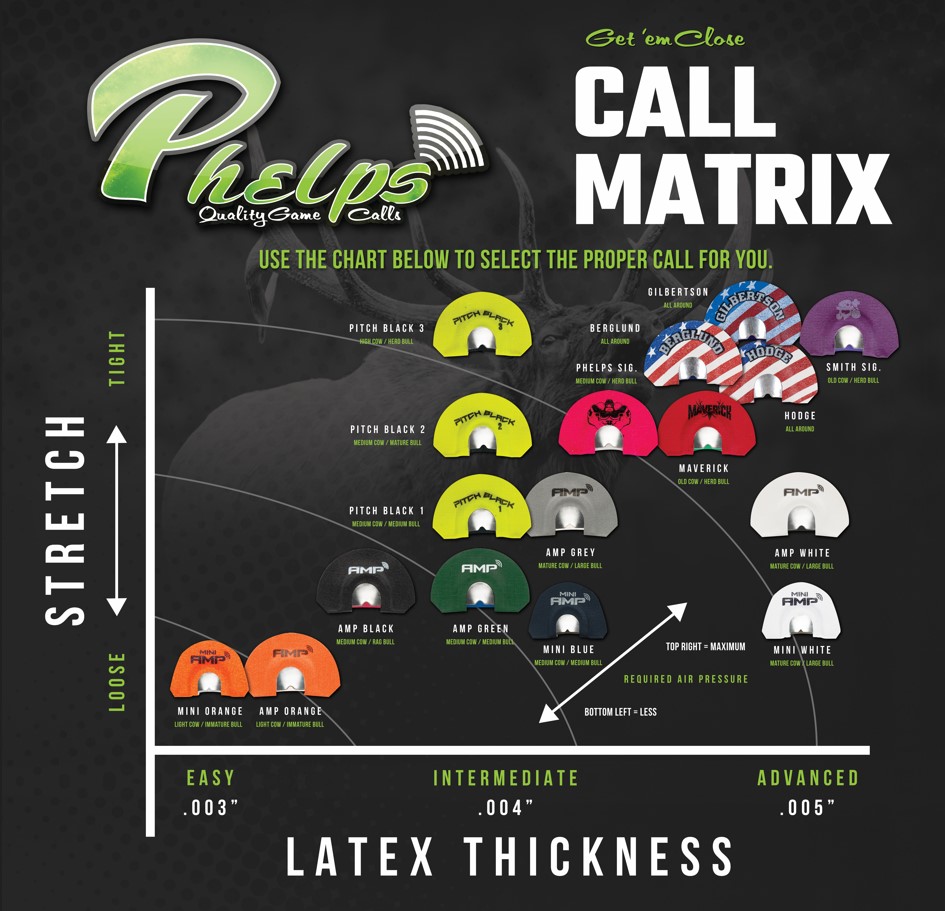Phelps Game Calls Elk Diaphragm Call MatrixUpdated 9 months ago
One of the most common questions we typically receive from our customers here at Phelps Game Calls is "Which Elk Diaphragm is right for me?" or "What elk diaphragm would you recommend I purchase?". Though it may seem like an easy question to answer, there's a lot more than goes into recommending diaphragms than you might think!
How much calling experience do you have with diaphragms? What sounds are you looking to make? Do you typically find yourself over-blowing your diaphragms? Are you looking for volume, sound nuance, durability, or ease of use? These are all questions you can expect a member of our team will ask prior to making any diaphragm recommendations--but thankfully, our Call Matrix makes picking out the best diaphragm for you rather easy. Below, our Call Matrix is explained!
Phelps Game Calls Elk Diaphragm Call Matrix

When reviewing our call matrix, it's important to pay attention to the X and Y axis of the matrix.
X AXIS:
Corresponds to Latex Thickness used within the reed of the diaphragm, increasing in thickness from left to right (measured in thousandths).
Y AXIS:
Corresponds to the stretch of the latex reed within included within the diaphragm--increasing in tightness from bottom to top.
As a general rule, diaphragms located at the bottom left of our Call Matrix are going to be easier to play and use than diaphragms at the top right; but, let's dig in deeper.
How does latex thickness and stretch determine the sound profile and playability of a diaphragm call?
The answer to this question is simple, latex thickness and strechability work together to control the pitch of a diaphragm, it's ease of use, and it's overall volume potential.
Thickness:
Latex thickness will ultimately determine a diaphragms ease of use as it's directly correlated to the amount of air and tongue pressure required to adequately control the diaphragm, as well as the diaphragms volume potential. Thin latex diaphragms require less air and tongue pressure to play than those that are thicker, and thus thin latex reed are generally best suited to beginner callers who have yet to master their calling techniques. These reeds are also generally a bit quieter than their thicker counterparts.
Diaphragms that utilize thick latex require a significant amount of air and tongue pressure to play, though more importantly require a solid foundation of calling fundamentals to utilize effectively. Because the latex is thicker, these diaphragms are also typically louder!
Stretch:
Explaining stretch is easy. Stretch corresponds directly to the pitch of a diaphragm--"loosely" stretched diaphragms produce lower sounds more effectively than those that are tightly stretched. Tightly stretched diaphragms produce higher pitched sounds better than those that are loose. It's that simple.
How does this affect which diaphragm you should choose?
Considering latex stretch and latex thickness used within a diaphragms construction will ultimately allow you to determine which diaphragm is going to be best for you based on your experience level and the type of calls you are looking to make during your hunts!
For inexperienced elk callers, or those looking to produce exclusively soft cow calls, you'll want to stick as close to the bottom left side of the matrix above as possible. These diaphragms are going to be easy to use and control, and sound great when looking to make softer, less aggressive cow and calf sounds. They also provide you with a great foundation for learning the basics of bugling and chuckling at bulls, though won't produce those big, full, intimidating bugles you've likely heard Jason or Dirk make in the majority of our videos--and that herd bulls typically respond to extremely well. They're still a great option for experience callers as well, especially those looking to call to smaller satellite bulls, or for those looking to cow call to a larger bull that's up close and personal. The Amp Orange, Amp Black, and Amp Green are a mainstay within our personal calling kits for this very reason! For those young but eager callers in your life (or adults with smaller pallets), the Mini Orange and Mini Blue are great starting points as well, and provides them with a variety of easy to use diaphragms to start their calling career.
Moving to the top right of our call matrix, this is where you find not only our loudest, but our most durable and nuanced diaphragms. These diaphragms are generally going to be best suited to experienced callers, those that typically find themselves overblowing their diaphragms, or those that are looking to produce big bull sounds. Moreover, and considering the latex used within these diaphragms is thicker and stretched tighter than those at the bottom right, the lifespan of these diaphragms is generally longer as well. These calls are going to be much harder to control and will require a lot of air pressure to play, but will also allow you to produce more nuanced bugles, chuckles, lip bawls, and barks--which can play a huge part in the success of your hunt. For beginner callers that may not have mastered the basics but typically utilize more air and tongue pressure than our lighter, less stretched diaphragms can handle, these are also a great option! A few personal favorites of our staff are the Maverick designed by World Elk Calling Champion Dirk Durham (our most durable diaphragm), the Amp White and Mini-White, the Phelps Signature, and our All-American 3 Pack.
We hope that helps you better understand our Call Matrix, and how it can be used to determine which Elk Diaphragm you should buy! As always, if you have any further questions or would like to chat with our team to gain further insight around which diaphragm may work best for you, please don't hesitate to reach out to our team via the Contact Us form linked below.
Have a great rest of your day, and happy hunting!